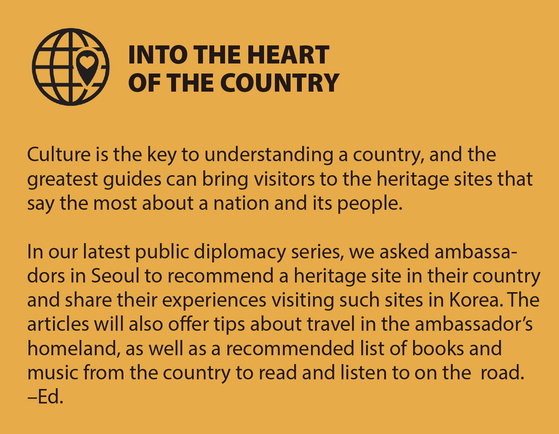[Into the heart of the country] Tracing the footsteps of gods, spirits and followers
![One of 72 stupas, each holding a statue of Buddha, on the Borobudur Temple Compounds in central Java, Indonesia. The temple compounds, dating back to the 8th and 9th centuries, were inscribed as a Unesco World Heritage site in 1991. [BOROBUDUR PARK MANAGEMENT]](https://koreajoongangdaily.joins.com/data/photo/2021/08/22/aafd3bb7-523a-441b-b8bd-bc9741372b5e.jpg)
One of 72 stupas, each holding a statue of Buddha, on the Borobudur Temple Compounds in central Java, Indonesia. The temple compounds, dating back to the 8th and 9th centuries, were inscribed as a Unesco World Heritage site in 1991. [BOROBUDUR PARK MANAGEMENT]
Indonesian envoy talks connections with Korea on heritage

“The Borobudur Temple has been a pride of the Indonesian nation for centuries, so it was only logical to have it enlisted on Unesco, not only to preserve it, but also to share its grandeur and intrinsic teachings and values with the world,” said Hadi.
The temple compounds — consisting of the Borobudur Temple and two smaller temples — are located in the center of Java, Indonesia. Dating back to the 8th and 9th centuries, the temple compounds were inscribed as a Unesco World Heritage site in 1991 and to this day still make up the largest discovered Buddhist monument.
The main temple is placed atop a natural hill and is three-tiered: It starts with a pyramidal base with five square terraces; on top of the base are three circular platforms; and the last tier is the stupa on the top.
The pyramidal base and the three platforms have walls decorated with fine reliefs, which altogether consist of some 2,520 square meters (27,125 square feet) in surface area. Some guidebooks recommend visitors walk in a counterclockwise direction to view and meditate upon the reliefs.
The circular platforms altogether hold 72 stupas, each of which holds a Buddha statue.
![Reliefs on the walls of the Borobudur Temple Compounds [BOROBUDUR PARK MANAGEMENT]](https://koreajoongangdaily.joins.com/data/photo/2021/08/22/94d782cf-76b2-4f63-94cc-330c6f58ca6e.jpg)
Reliefs on the walls of the Borobudur Temple Compounds [BOROBUDUR PARK MANAGEMENT]
![An archway at the Borobudur [BOROBUDUR PARK MANAGEMENT]](https://koreajoongangdaily.joins.com/data/photo/2021/08/22/51a5ff02-4ea4-4353-8aa3-64dddd2b4bc4.jpg)
An archway at the Borobudur [BOROBUDUR PARK MANAGEMENT]
“The temple compounds were built when Buddhist kingdoms or empires were ruling the archipelago,” said Hadi. “We’ve had a few strong Buddhist empires throughout our history, and their influence was not limited to the Indonesian archipelago but stretched up to the Indochina regions. But then at a later point in our history, the kings and kingdoms embraced Islam.”
Across the centuries, parts of Indonesia came under the influences of Hindu, Buddhist, Islamic, Christian and even foreign rulings, so it’s not a surprise to find distinct heritages on culture and religious beliefs across its more than 17,000 islands.
That kind of history has resulted in a nation and its people for whom holding onto a belief in a greater being has become a way of life.
“Being religious is part of our national ideology — we have what is called the Pancasila, or five principles of what it means to be an Indonesian, and the first of the five principles is belief in God,” Hadi said.
The ambassador recalled how some of his fondest memories growing up involved visits to temples with his friends and families.
“My family do not adhere to Buddhism, but we loved visiting some of the Buddhist temples, located beautifully on hills or nestled in nature,” said Hadi.
And this is a connection he made during his four-year tenure in Korea.
Hadi and his family visited the Bulguksa Temple in Gyeongju, North Gyeongsang, not long after his tenure in Seoul began in 2017. They also frequent the Jongmyo Shrine in central Seoul.
![Seokguram Grotto made of granite holds a statue of the Sakyamuni Buddha and reliefs of bodhisattvas and disciples on the surrounding walls. The grotto, along with the Bulguksa Temple in Gyeongju, North Gyeongsang, was inscribed as a Unesco World Heritage site in 1995. The grotto is considered a masterpiece of East Asian Buddhist art that flourished in Gyeongju, which was the capital of the Silla Kingdom in the 8th century. [CULTURAL HERITAGE ADMINISTRATION]](https://koreajoongangdaily.joins.com/data/photo/2021/08/22/13bc4ea5-0b92-4ed8-a839-0a7e051c10e4.jpg)
Seokguram Grotto made of granite holds a statue of the Sakyamuni Buddha and reliefs of bodhisattvas and disciples on the surrounding walls. The grotto, along with the Bulguksa Temple in Gyeongju, North Gyeongsang, was inscribed as a Unesco World Heritage site in 1995. The grotto is considered a masterpiece of East Asian Buddhist art that flourished in Gyeongju, which was the capital of the Silla Kingdom in the 8th century. [CULTURAL HERITAGE ADMINISTRATION]
The Korea JoongAng Daily recently sat down with the top envoy from Indonesia to hear more about the parallels he has drawn between the culture and heritage between Indonesia and Korea during his four years of tenure in Seoul, and to ask for his tips on planning a trip to the Borobudur Temple, for those making plans for a post-pandemic vacation, or even for those looking to do some armchair traveling.
The following are edited excerpts of the interview.
![Ambassador of Indonesia to Korea Umar Hadi speaks with the Korea JoongAng Daily at the diplomatic residence in Seoul on July 23. [PARK SANG-MOON]](https://koreajoongangdaily.joins.com/data/photo/2021/08/22/9e99301f-1c10-4e43-91af-3a000b170296.jpg)
Ambassador of Indonesia to Korea Umar Hadi speaks with the Korea JoongAng Daily at the diplomatic residence in Seoul on July 23. [PARK SANG-MOON]
Another option is to look into homestays in the villages near the Borobudur. The local tourism office would have this information.
![Monohara Hotel, one of the accommodations near the temple compounds. [BOROBUDUR PARK MANAGEMENT]](https://koreajoongangdaily.joins.com/data/photo/2021/08/22/6d24dcc5-08eb-4eea-a3aa-7e0cca763c25.jpg)
Monohara Hotel, one of the accommodations near the temple compounds. [BOROBUDUR PARK MANAGEMENT]
Some Korean friends have told me about a Korean sentiment called han, which can be translated to mean a feeling of grievance, or suffering. And I heard that this may have to do with the struggles Korea as a nation had to endure in his past.
I mentioned this Korean example because I think there is also a type of Indonesian way of thinking, that may not be something that every Indonesian bears, but there is this spirit of acceptance, or surrendering, to a spiritual being. In other words, if something happens to you, you accept it and go with the flow of life. Even if what took place brought you suffering, you accept it as a cause of the higher being, thinking that God still loves you and this might be how God is testing your beliefs. Perhaps that is why people say Indonesians tend to smile a lot.
![Borobudur Temple Compounds during a sunrise on a misty day [BOROBUDUR PARK MANAGEMENT]](https://koreajoongangdaily.joins.com/data/photo/2021/08/22/0e7e2b13-7e33-43fc-8c59-40fa896700da.jpg)
Borobudur Temple Compounds during a sunrise on a misty day [BOROBUDUR PARK MANAGEMENT]
We especially love watching the traditional dance during the ceremony at Jongmyo. The traditional dances can be a spiritual experience. I learned how to dance some Balinese mask dances, and one that I am particularly fond of is what’s called the strong-man mask dance. The dance is designed so that the dancer, behind the mask, appears powerful, because of the moves and the rhythms involved. I heard that in Korea there is also a dance that used to be done only by men, called the crane dance. So you see there are some similarities in the way we have traditionally incorporated dances into our culture.
I appreciate K-pop concerts, because they try to provide clean entertainment for teenagers. And oftentimes they carry a message on climate change or other global issues. I think the K-pop boom is thanks to the tremendous cultural innovation of the people of Korea, and I admire and appreciate their contribution.
Our plan was to open Bali to Koreans by winter, but we’ll have to see how the situation develops from here.
![Borobudur Temple Compounds [BOROBUDUR PARK MANAGEMENT]](https://koreajoongangdaily.joins.com/data/photo/2021/08/22/a0f77d65-5dc3-4e85-9481-db1194a1d58d.jpg)
Borobudur Temple Compounds [BOROBUDUR PARK MANAGEMENT]

• Capital city: Jakarta
• Area: 1.9 million square kilometers (about 17 times the size of South Korea)
• Population: 275.1 million (2021)
• Main language: Bahasa Indonesia, English, Dutch, local dialects
• Ethnic groups: Around 1,340 ethnic groups
• Religions: Islam, Protestantism, Catholicism, Hinduism, Buddhism and Confucianism
• National day: Aug. 17, Independence Day
• Government type: Presidential republic
• Currency: Indonesian rupiah
Travel tips
• Best time to visit: Indonesia has two seasons — rainy and dry — and has warm temperatures all year long.
• Recommended modes of transportation: Take a direct flight from Incheon to Bali, stay on the island for a while to enjoy its beaches and sunsets, and take a flight (about an hour) to Yogyakarta. Enjoy the historical sites in the city, take a bus or cab (an hour) to Megelang, a city close to Borobudur Temple.
• Recommended accommodation: Stay at an accommodation at Megelang if you’re looking to visit the temple compounds at dawn to watch the sunrise. The local tourist offices will also have information on homestays with the locals living near the temple.
• What to eat: Sate ayam (skewered chicken) or sate kambing (skewered lamb), served with local sauces including peanut sauce, and beer. Be adventurous in trying different types of satays, including those made with young mutton, goat, veal and mussels. For those looking for vegan or vegetarian options, tempeh satays will also be available at some stalls.
• Books to read before the trip: “Why Indonesia” by Bang Jung-hwan (Korean), “Funky Southeast Asia” (translation) by Kim E-je (Korean), and “Eat, Pray, Love: One Woman's Search for Everything Across Italy, India and Indonesia” by Elizabeth Gilbert
• Movies to watch: “A Perfect Fit” (2021) on Netflix and “Bali: Beats of Paradise” (2019)
• Music to listen to: “'Bengawan Solo' Cover” by Lee Jung-pyo, which is an adaptation of Indonesian traditional song Bengawan Solo using gayageum (Korean traditional zither)
![The temple compounds during a sunset [BOROBUDUR PARK MANAGEMENT]](https://koreajoongangdaily.joins.com/data/photo/2021/08/22/62ce6089-3345-4ff7-9711-3e579e3b02e6.jpg)
The temple compounds during a sunset [BOROBUDUR PARK MANAGEMENT]
BY ESTHER CHUNG [chung.juhee@joongang.co.kr]










with the Korea JoongAng Daily
To write comments, please log in to one of the accounts.
Standards Board Policy (0/250자)